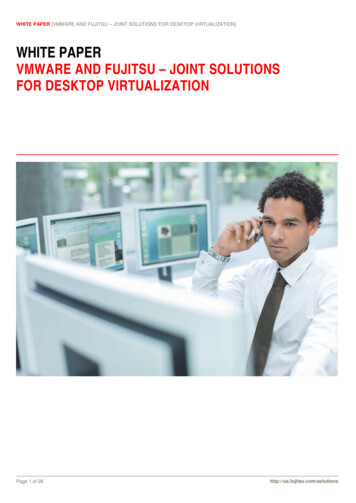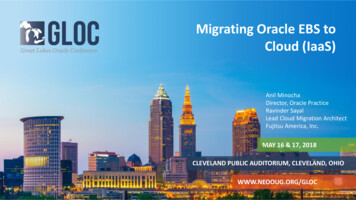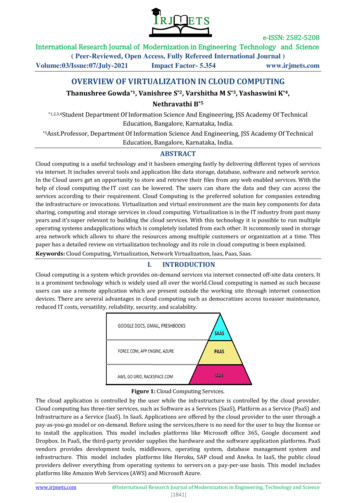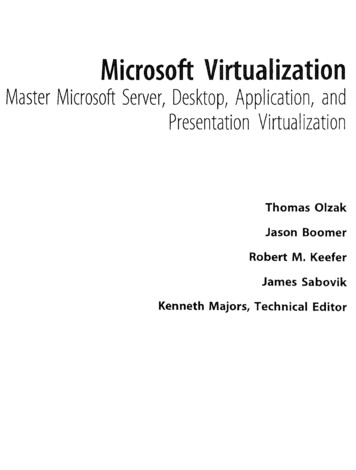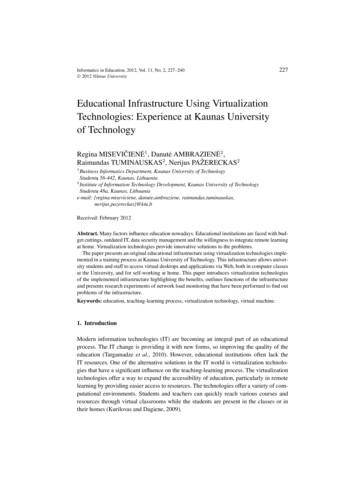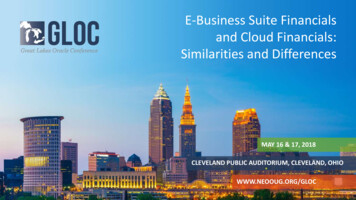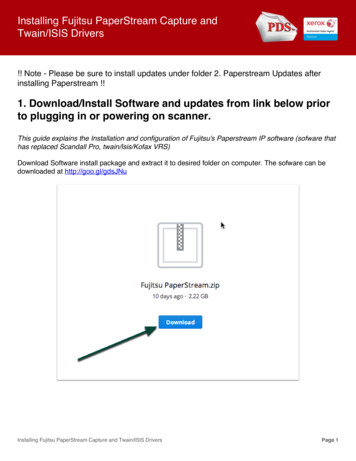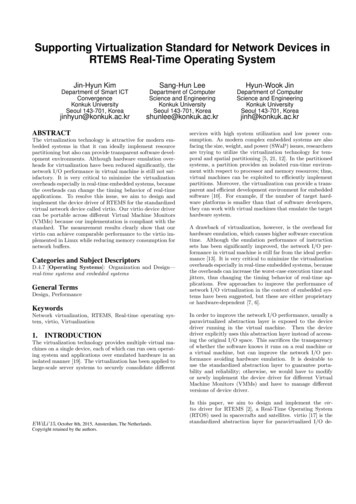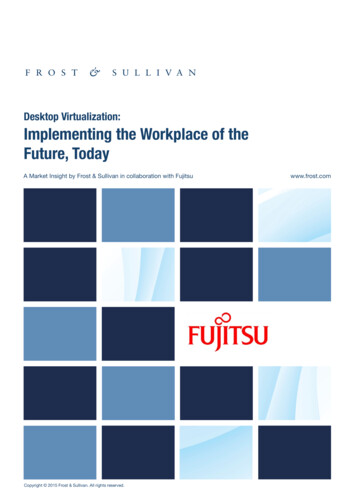
Transcription
Desktop Virtualization: Implementing the Workplace of the Future, Today1Desktop Virtualization:Implementing the Workplace of theFuture, TodayA Market Insight by Frost & Sullivan in collaboration with FujitsuWe Accelerate GrowthCopyright 2015 Frost & Sullivan. All rights reserved.www.frost.comwww.frost.com
2Desktop Virtualization: Implementing the Workplace of the Future, TodayTable of ContentsWORKPLACE OF THE FUTURE 3WHAT IS DESKTOP VIRTUALIZATION? 5VDI DEPLOYMENT MODELS 7EVALUATING THE IMPACT OF VDI 8SELECTING THE RIGHT VIRTUAL DESKTOP INFRASTRUCTURESOLUTION PROVIDER9FUJITSU’S VALUE PROPOSITION AS A VIRTUAL DESKTOP12SOLUTION PROVIDERHOW FUJITSU’S VDI SOLUTIONS HELP CUSTOMERS18CASE STUDY 1: SCHIPHOL GROUP 18CASE STUDY 2: MAJOR JAPANESE DISTRIBUTOR19THE FINAL WORD 20We Accelerate Growthwww.frost.com
Desktop Virtualization: Implementing the Workplace of the Future, Today3W O RK PLA C E OF T HE FU T U R EThe workplace of today is transforming the way employees carry out their daily activities. Enterprises are movingbeyond being desktop-centric to a multi-device anywhere, anytime workplace. Employees today take electronicnotes, collaborate using social media and video-conference either on their tablet PCs or via HD conference rooms.Four critical factors drive these changes: smart devices, changing information technology (IT) consumption trends,security requirements, and centralization of the IT infrastructure.Figure 1: Factors Driving Evolution of the WorkplacePROLIFERATION OF SMART DEVICESCHANGING IT CONSUMPTION TRENDSNEED TO SECURE END-POINTSCENTRALIZATION OF ITSource: Frost & SullivanWe Accelerate Growthwww.frost.com
4Desktop Virtualization: Implementing the Workplace of the Future, TodayPROLIFERATION OFSMART DEVICESThe proliferation of smartphones, tablets and wearables posessignificant management and security challenges. These days, ITdepartments need to support a greater array of devices and operatingenvironments than ever before to satisfy employees’ demand foranywhere, anytime access to their workplace.CHANGING ITCONSUMPTIONTRENDSIncreasing adoption of cloud computing and social media is shiftingcontrol away from IT departments and reinforcing security concerns.Organizational data is now increasingly stored outside the corporatenetwork and shared in new ways, this gives rise to Shadow IT1services. Likewise social media, while an excellent collaborative tool,also raises new challenges for the security and privacy of sensitiveinformation.NEED TO SECUREEND-POINTSWith an increase in vulnerabilities penetrating end-points, organizationsare now moving towards virtualized environments, reducing theperimeter of exposure as information is kept within a fortified datacenter as opposed to a home drive on a traditional end-user device.CENTRALIZATIONOF ITWith highly virtualized and cloud-based environments expected todominate the future, the centralization of IT becomes inevitable.The growing computing power in the hands of end users is creating new pressure points for IT departments in areassuch as regulatory compliance, Intellectual Property (IP), business agility, maintenance costs and productivity. ThisWhitepaper analyzes how virtual desktops can help to alleviate the challenges for IT departments to facilitate theworkplace of the future, today.1Shadow IT refers to IT systems and solutions built and used inside organizations without organizational or IT team approval.We Accelerate Growthwww.frost.com
5Desktop Virtualization: Implementing the Workplace of the Future, TodayW H AT IS D E SK T OP VIRT UA L I ZAT I O N ?In general, IT departments manage enterprise end-point devices by providing standardized hardware and softwareto employees. While this approach has helped to reduce the overall cost of implementation and management, itis fast becoming outdated. Employees today demand unprecedented levels of flexibility; Bring Your Own Device(BYOD) is becoming the norm in most enterprises with more than 60%2 of enterprises in developed economiesembracing this policy. As a result, enterprise IT is increasingly resorting to desktop virtualization as a way to offeremployees the flexibility they need while maintaining the same level of control and security.Frost & Sullivan defines Desktop Virtualization as “Technology that equips the end user with a full-fledged virtualoperating environment on their desktops, laptops, mobile phones or any other device that lacks the space andsophistication of a computer. Virtual desktops hide the physical existence of the actual desktop by offering virtualinstances of desktops to the user.”Desktop virtualization offers a strong value proposition for enterprises that require a solution to meet the challengesof the new IT landscape.Figure 2: Value Proposition of Desktop ongerdesktoprefreshcyclesAccess tomultipleOS andapplicationsENHANCEEFFICIENCY &RETAINCONTROLValue Proposition ofClient oncolidationSource: Frost & Sullivan2Source: Frost & Sullivan researchWe Accelerate Growthwww.frost.com
6Desktop Virtualization: Implementing the Workplace of the Future, TodayThe desktop virtualization value proposition offers the following business benefits for enterprises: Helps to reduce energy consumption, cooling costs and replacement rates that result in lower cost of ownershipand higher return on investment. Centralizes control of hardware, software, and applications that leads to increased utilization levels and lowermanagement costs. Enhances security, auditing, and other compliance from a central point of contact. Provides a wide range of operating systems and applications without the need to install individual desktops.While the desktop virtualization market is still at an early stage, it is witnessing strong growth momentum. Enterprisesare starting to realize the importance of client virtualization to manage the complex end-point environment of today.According to Frost & Sullivan, the strong adoption is expected to drive market growth with spending on desktopvirtualization projected to exceed USD8 billion by 2017, growing at just under 40% per annum from 2014 to 2017.Frost & Sullivan identifies two forms of desktop virtualization: local and remote desktop virtualization. Under localdesktop virtualization, the hypervisor is set up on the client hardware and uses either direct hardware virtualization oran OS-based virtualization. However, local desktop virtualization has yet to achieve significant enterprise adoptionwith limited use cases.On the other hand, remote desktop virtualization is seeing greater adoption among large enterprises across theworld. Under remote desktop virtualization, or Virtual Desktop Infrastructure (VDI) as it is commonly known, thehypervisor sits on the server to host multiple unique and isolated client operating systems on a single server orgroup of servers in the data center environment. The virtual desktops are delivered to end users’ devices via thenetwork.Figure 3: Remote Desktop Virtualization or Virtual Desktop Infrastructure (VDI)ApplicationsApplicationsOSGuest OSNetworkHypervisor (Bare metal)HardwareSource: Frost & SullivanWe Accelerate Growthwww.frost.com
Desktop Virtualization: Implementing the Workplace of the Future, Today7Another virtualization model that is becoming highly prevalent across the globe, and perhaps witnessing higheradoption than VDI, is application virtualization. Application virtualization involves running application softwarefrom a remote server eliminating the need for the user’s computer where the application resides. This isolates theapplication from the local operating system, resulting in secure, remote access to the application from any placeas any changes made on the target machine will not be reflected on the local machine. This offers significantcost-savings on hardware and provides the ability to use existing hardware optimally. It also provides a solution toincompatibility issues of an application with the underlying OS and secure execution of an application.VD I DEPLOY M E N T M OD E L SAs VDI is not a one-size-fits-all approach, it is essential to understand its different forms and identify the mostsuitable one for your organization. Enterprises have the choice to run the VDI solution within their data center or optfor a hosted model offered by service providers. The deployment models3 are outlined below: In-house VDI: Mostly adopted by large enterprises, this is the most prevalent form of virtual desktop services.Solution providers continue to develop innovative security offerings for virtual desktops with significant effortsbeing invested on how to reduce the costly hardware set-up required for deploying virtual desktops. Thisdeployment allows enterprises complete control over software, hardware, and data. That stated, small andmid-sized firms do on hesitate implementing an in-house VDI model due to initial set-up costs, deploymentcomplexities, and management skills required. Desktop as a Service: Several service providers offer virtual desktops as a managed offering that requirelower initial set-up costs, as there is no need for a major server and storage infrastructure from the user and isless complex to deploy and manage. Virtual desktops can be accessed from either the Internet or via a privatenetwork. Although there is scope for personalization, user experience is rather limited due to poor streamingof multimedia content. However, technologies supporting high-definition content and more efficient processingare helping to overcome this challenge. Security and loss of control continue to be major stumbling blocks forthis delivery model as most enterprises believe that an in-house solution is more secure than one hosted by athird-party. More recently, service providers and solution vendors have introduced cloud-based VDI solutionswhere initial set-up cost is minimized with cloud configuration. While security and data sovereignty remainsa critical concern for cloud-based solutions, however, with high interest and innovation in this area, theselimitations are likely to be addressed in the near future. In fact, there is a strong growth momentum for DaaS inthe US. In a recent Frost & Sullivan survey4 of US businesses, 55% of respondents stated that they are usingcloud-based desktop virtualization.Deployment models are applicable only for remote virtualization. Local virtualization can only be performed on theclient device.3Source: Frost & Sullivan’s 5th Annual Cloud User Survey of US-based IT Decision-Makers conducted in 2014 with401 technology decision-makers participated in the survey.4We Accelerate Growthwww.frost.com
8Desktop Virtualization: Implementing the Workplace of the Future, TodayEVALUATIN G T HE IM PAC T O F V D IWhile it has been established that VDI provides immense benefits to enterprises looking to change the way theyengage and empower their employees, it is essential for businesses to gain a better understanding of the benefitsand potential challenges of VDI implementation. A sound knowledge should help CIOs to make more informeddecisions in formulating an effective strategy for workplaces of the future. Frost & Sullivan research with enterpriseIT decision-makers highlight the following benefits and concerns with VDI.B e n e fi ts of V DI Impl ement a t i o nLower Total Cost of Ownership: By shifting to a VDI environment, enterprises are able to lower their total costof ownership (TCO) for employee desktops. For example, an organization with 1,000 employees was able to savealmost USD1 million or about 20-25% over a 3-year period by moving to Citrix’s XenDesktop Platinum Edition.While the cost-savings may be limited at the infrastructure and software layers, they increase exponentially whenevaluating time invested in setting up, managing and upgrading traditional desktops. The cost-savings are evenhigher in the DaaS delivery model where initial investment and management is the responsibility of the serviceprovider or vendor.Operational and management challenges associated with the legacy set-up: With the traditional computerinfrastructure installation in any sector, operational issues or helpdesk requests take hours or days to be resolved,negatively affecting employee productivity. VDI allows real-time analysis of faults or issues, and either initiateautomated corrective measures or provide IT administrators with proactive information to take the necessarycorrective actions.Increasingly dynamic business requirements: The scaling up and down of resources, concurrent access todifferent versions of the same application, and separate workstations for employees across different shifts are someof the business requirements in many sectors. Virtualized desktops are able to cater to all these requirements atminimal cost.Securing a flexible, multi-device environment: With the proliferation of compact tablets and smartphones, theend user prefers these devices to a bulky laptop. Several users carry secure data in hand against their wishes dueto necessity and lack of data mobility. According to industry estimates, nearly half of enterprises have experiencedloss of data in a multi-device or a BYOD environment. By implementing VDI, enterprise IT can continue to controldata across all devices, either at rest or in motion. Since all enterprise data resides in a central data center, there isno data residing on the end-points.Strong momentum for cloud computing: The rapid growth of cloud computing is a direct driver for VDI adoption,as the emphasis of data processing and storage moves away from end-points and towards the server.We Accelerate Growthwww.frost.com
Desktop Virtualization: Implementing the Workplace of the Future, Today9Chal l e n g e s w i t h VDI Impl ement a t i o nComplex and capital-intensive initial set-up: In order to generate several virtual desktop instances, a sophisticatedinfrastructure and software configuration is required. Setting up this infrastructure can be costly, complicated,and require extensive planning and robust hardware and software solutions. This can result in high set-up costs,especially when implementing an in-house VDI deployment model.Limited network availability: Virtual desktops are generated in a central location and transmitted to the end userthrough existing networks. Virtual desktops require a considerable amount of bandwidth as all the desktops alongwith the operating environment is virtually loaded and streamed across the network.User experience: Virtual desktops are unable to completely fulfill user expectations like a physical desktop can.Delays, increased operational time, and poor multimedia content streaming could negatively affect the experience,rendering graphics or computationally-extensive tasks. Greater initial investment and technical expertise are neededto overcome these challenges that may not always exist within the enterprise.Limited personalization: Unlike server virtualization, virtualized desktops need to cater to a variety of userswith different requirements. Right from the wallpaper to the applications on the desktop, users have individualpreferences. Also, the content and information each user accesses vary daily. For example, a user may access videostreaming one day and mostly check email the next.Complex security landscape: With all client data residing on the server and desktops being virtual, the risk ofbeing affected by an external threat increases significantly. Securing virtual environments require a new approachand implementation, such as agent-based security solutions. While security service providers continue to introducefocused solutions for the market segment, their comprehensiveness remains a key concern for enterprises.SELECTING T HE RIGHT VI RT UA L D ES K T O PI N FRASTR U C T U RE S OL U T I O N P R O V I D EROnce a suitable deployment model is chosen for your enterprise, the next step is to choose the right VDI solutionprovider. According to Frost & Sullivan’s survey of IT decision-makers, eight key factors emerge when evaluatinga VDI solution provider which can either be classified under business or technical considerations as illustrated inFigure 4.We Accelerate Growthwww.frost.com
10Desktop Virtualization: Implementing the Workplace of the Future, TodayFigure 4: Factors to Evaluate a VDI Solution ProviderFACTORS TO EVALUATE A VDISOLUTION PROVIDERBUSINESSTECHNICALTHOUGHT LEADERSHIPSOLUTIONS PORTFOLIOPROVEN METHODOLOGIESIMPLEMENTATIONCAPABILITIESTRANSPARENT PRICINGSECURITY FRAMEWORKSSUSTAINABILITYUSER EXPERIENCEMANAGEMENTSource: Frost & SullivanB u s i n e s s Fac tors Thought Leadership: With the IT industry evolving at a rapid pace, it is essential to partner with an industrythought-leader for your VDI solution. As a thought leader, the solution provider will be able to incorporateanticipated changes in the workplace and provide invaluable insights into managing the move to virtual desktops.Proven Methodologies: A concrete way to evaluate a solution provider is to look at their past track record toassess their expertise and services. A solution provider that has multiple successes of partnering their customerson this transformative journey will have the edge over newer entrants into the market. Hence, it is essential tocross check claims and promises against actual on-ground delivery.Transparent Pricing: Cost is a factor that is paramount in evaluating a shift to virtual desktops and selectingthe right solution provider. It is essential to understand costs holistically and engage a provider that offerstransparent pricing. This will enable the client to manage project expectations and costs better. Moreover,it prevents unexpected costs, for example, a significant spike in bandwidth requirements that may mandateincreased expenditure.Sustainability: Decision makers need to carefully examine the solution provider’s long-term sustainability andfinancial stability, especially when engaging new market entrants. The management of virtual desktops requiresnew skill sets that may not be available in all enterprises. Furthermore, the viability of the solution over the longterm is essential to ensure implementation success.We Accelerate Growthwww.frost.com
Desktop Virtualization: Implementing the Workplace of the Future, Today11Te c h n i c al Fac tors Solutions Portfolio: Desktop virtualization is an enterprise-wide activity and requires alignment across multipletechnologies. Coordinating these domains and putting together a solution from multiple vendors createschallenges at various levels such as integration, compatibility and lock-in. Enterprises need to choose a solutionprovider that is able to assemble a solution that meets the business and technological requirements of theenterprise in the long run. Therefore, it is essential to select a service provider that can offer the entire valuechain of offerings from the underlying hardware to the software management instead of a piecemeal-basedsolution.Implementation Capabilities: As each enterprise is different, their requirements and pace of change are alsounique. This requires the solution provider to be flexible in managing the solution implementation. The solutionprovider should not only be able to tailor their offering according to the implementation stage, but also define thepace of implementation in line with the enterprise’s ability to integrate new technology. Above all, the solutionprovider should be able to manage the end-to-end lifecycle of the transformation to virtual desktops.Security Frameworks: The implementation of a centralized desktop infrastructure does enhance security andprivacy. However, enterprises need to be cognizant of managing the security of the virtualization platform anddata at rest and in motion. For example, with workplaces now residing in the data center, it is essential to separatethe underlying infrastructure from the one hosting mission-critical applications to help isolate any threats. Whiletraditional security challenges such as patching and anti-malware do not go away, they do become easier tomanage due to centralization. A service provider that clearly understands the changing security postures withthe centralization of workplaces will be able to manage the enterprise security framework better and providecomprehensive protection.User Experience Management: With the entrance of Millenials in the workforce, collaboration and social mediaare becoming increasingly embedded in the workplaces of today. Employees expect a richer user experienceon any device, anywhere, including access to all applications, content and rich media collaboration. What’smore, they follow the 3-second rule where an application should respond within that brief timeframe to meettheir performance expectations. Traditionally, desktop virtualization has faced challenges in supporting mobileand BYOD devices and providing high-quality communications, such as high-definition video. The solutionprovider needs to plan a comprehensive workplace experience that can be delivered to a broad range of fixedand mobile devices, without any compromise to the end user experience.The factors above may be adapted to your enterprise’s VDI solution provider selection guidelines. Ultimately,the chosen solution provider should be able to eliminate performance bottlenecks successfully, ensure end userexperience and reduce clutter and complexity in managing workplaces.We Accelerate Growthwww.frost.com
12Desktop Virtualization: Implementing the Workplace of the Future, TodayFUJITSU’ S VALU E P ROP OS I T I O N A S A V I RT UA L D ES K T O PSOLUTIO N P ROV ID E RAs a leading provider of IT services and solutions across the globe, Fujitsu envisions a future where human-centricICT can help inspire a more intelligent society, a better environment for people and a better place to conductbusiness, creating a sustainable place to live and prosper.FUJITSU Mobile Initiative is the latest of Fujitsu’s ongoing efforts to leverage our vertical integration and customizationcapabilities to respond to the diverse mobile technology needs of customers and society. Through this initiative,Fujitsu will deliver customers ideal mobile solutions by putting in place a structure that encompasses the company’scomprehensive lineup, ranging from mobile devices and network technologies, to security and mobile communicationplatforms and applications, together with its mobile integration and operational services that are backed by its longtrack record.FUJITSU Workplace Anywhere value proposition is a blended managed workplace service that provides enterprisecustomers complete control and flexibility to end-points in a manner of their choosing without compromising onperformance, security, control and costs. Fujitsu is committed towards delivering managed infrastructure servicesthat enable employees to work productively, anytime and anywhere they choose. The service covers all key essentialof a workplace solution from an end-to-end perspective.Fujitsu offers a broad portfolio of workplace solutions to meet the differing needs of customers. It believes that “onesize does not fit all” and hence, its extensive portfolio enables the company to handle any end-user service. Thisincludes every aspect of the desktop lifecycle – from procuring and managing thick-and-thin clients, delivering hostedapplications and virtual desktops, supplying cloud-based enterprise mobility services, providing managed printservices, desk-side support and service desk services, to the responsible disposal or redeployment of technologyat the end-of-tlife stage. Fujitsu’s approach towards desktop virtualization engagements follows a 4-step process:Figure 5: Fujitsu’s Approach to Desktop Virtualization EngagementsASSESSMENTFujitsu begins the process with a comprehensive and knowledgeable assessment of anorganization’s technology, applications and user environments.Fujitsu uses a comprehensive ROI model – developed through actual experience in clientengagements – to identify both long-term and “quick wins” cost saving opportunities.PROFILINGUser roles are mapped across the organization based on assessment data, application types aswell as data and service access needs.The result is a set of build models that are used to create common, standardized technologyroles to reduce operational cost, and provide commonality across users.We Accelerate Growthwww.frost.com
13Desktop Virtualization: Implementing the Workplace of the Future, TodayUSER ENGAGEMENTAs the move to virtual desktops can a huge shift for many employees, Fujitsu leverages theprofile data to provide a positive user experience through relevant user training and support.PLANNINGFujitsu creates a comprehensive, informed delivery plan that enables enterprises to realize costsavings in a short time-frame and at minimal risk to the organization.Source: Frost & SullivanFujitsu’s clearly-defined approach provides the flexibility and agility to tailor desktop virtualization solutions to meetthe unique needs of enterprises. Today, the company is responsible for managing approximately 5 million desktopdevices globally, including 2.9 million across Europe – and is the number one desktop service supplier to the UKGovernment. In addition, Fujitsu is a leading global systems integrator for desktop virtualization projects, deliveringsome of the largest and most complex desktop transformations as Citrix’s number one certified solutions integrator.A clear business case drives these projects providing business agility, supported by the requirement to reduce thecosts of managing the end user environment. Overall, Fujitsu services save a typical customer up to 30% of theirservice costs. With the latest innovations around cloud-based “as a service”, it expects enterprises to save up to40%.T he F u j i ts u De skt o p Vi rt ua l i z a t i o n SolutionsBased on its vast experience in creating and implementing virtual desktops for a number of clients across theglobe, Fujitsu has established two desktop virtualization offerings: the Fujitsu VDI Solution for Enterprise and FujitsuVirtual Client Services (VCS). While the former is suitable for customers looking to deploy an in-house VDI solution,the latter is targeted at customers looking to implement a flexible solution that leverages on Fujitsu’s managedinfrastructure services, business applications services, and an array of enterprise products. Both offerings have theirunique benefits and can be implemented in varying business environments.F u jits u V D I S ol ut i o n f o r E nt erpri seThe Fujitsu VDI Solution for Enterprise is a packaged solution that delivers VDI benefits with a rich client userexperience. With scalable VDI bundles, it is easier for companies to make the switch to a virtual desktop environment.The solutions offer users wider flexibility and allow an enterprise to run any application in the environment. At thesame time, the template-based deployment solutions provide IT administrators the tools to centrally manage andvirtualize the desktop and applications in a secure and efficient manner.We Accelerate Growthwww.frost.com
14Desktop Virtualization: Implementing the Workplace of the Future, TodayFigure 6: Fujitsu VDI Solution for EnterpriseClient deviceSMARTPHONE / TABLETFUTRO CLIENTThin ClientSmartphoneiOSWINDOWS CLIENT OSVMWARE HORIZON VIEWWINWINWINWINVMWARE VSPHEREWINWINTabletTradtional PCVDICITRIX XENDESKTOPWINWINMICROSOFT HYPER-VPRIMERGYETERNUSWINWINWINWINCITRIX XENSERVERSoftwareSERVERVIEW RESOURCE ervisorServerStorageSource: FujitsuWe Accelerate Growthwww.frost.com
Desktop Virtualization: Implementing the Workplace of the Future, Today15Key features of the Fujitsu VDI Solution for Enterprise include: Substantial solutions expertise – Leveraging on its systems capabilities and proven processes, Fujitsu developsand implements high-quality solutions for multiple enterprises of varying sizes across the globe. Its solutionshave been tested in partner environments and demonstrate strong performance levels against benchmarks.Deep domain expertise – Fujitsu brings its substantial experience of working with VDI solutions from multiplevendors such as VMware and Citrix, and an in-depth knowledge of the hardware that enables desktopvirtualization. By incorporating its domain expertise and hardware capabilities into the solution, the company isable to add significant functionalities to the solution.Enable cloud-based solution – By enabling a cloud-based solution, Fujitsu provides enterprises with the abilityto pool together resources to ensure better resource utilization; provide billing data for service charge; and easeof operation and management.Apart from the benefits above, another point of differentiation for the Fujitsu VDI solution is software expertise.Fujitsu’s ServerView Resource Orchestrator Cloud Edition (ROR CE) is a cloud management platform thatenhances the lifecycle efficiency of virtual desktops. Some of the main advantages of ROR CE working in tandemwith the VDI solution include: Reduction of deployment time by up to 40%. Easier management of the VDI environment through a graphical portal which provides a unified view of theinfrastructure and virtual PCs. Enhanced system reliability through resource monitoring and automatic failure prevention.F u jits u V i r tu al C l i ent Ser vi ces ( VC S) Offe r ingThe Fujitsu VCS Offering is a tailored solution that delivers Hosted Virtual Desktops (HVDs), Hosted Shared Desktops(HSDs), User Virtualization and Application Virtualization through the integration of a series of hardware, softwareand service elements. These elements work in tandem to deliver a feature-rich environment that accommodatesindividual users and business objectives based on compute, application, and da
The desktop virtualization value proposition offers the following business benefits for enterprises: . desktop virtualization, the hypervisor is set up on the client hardware and uses either direct hardware virtualization or an OS-based virtualization. However, local desktop virtualization has yet to achieve significant enterprise adoption .
